Which came first: the whales or the whale tail?
Here on the Pacific Coast of Costa Rica, there’s a most curious case of nominative determinism. Twice a year, humpback whales swim toward the warm waters in order to mate or give birth. The setting on land is absolute paradise: palm trees, golden sands, sunshine, and not a single high-rise in site.
Indeed, the whales are certainly not the only mammals who flock here for mating purposes…
But, when the tides are low in a corner of this paradise, the waters part to reveal something that really can only be described as a whale tail.
Not an actual whale’s tail, though that would be more expected, but a strip of sand stretching out to a stage of rocks which, when viewed from above, does look remarkably like a the tail of a whale.
Is this what first attracted the giant creatures here so long ago? Or, did the land take its inspiration from the shapes seen in the depths? Or is it just a fateful, happy coincidence, a serendipitous quirk of nature?
Whichever version you lean to, the whales and their tails meant there could really only be one name for this national park in Costa Rica.
Created in 1990, Parque Nacional Marino Ballena (Whale Marine National Park ) protects over 13,000 acres of ocean, 9 miles of stunning coastline and the largest coral reef along the Pacific coast of Central America. Relatively young by the country’s national park standards, it is firmly established as a gorgeous place to have a day at the beach and, unquestionably, the best place to go whale watching in Costa Rica!
In this short post, we’ve shared a personal overview of Marino Ballena National Park, with all the information + inspiration to plan your visit perfectly.
Click Here to Read the Full Original Article at blog —ALONG DUSTY ROADS…
